A&P II Module 1: Endocrine System (Part 1, 2, 3) & Module 2: Blood (Part 1, 2)
1/146
Earn XP
Name | Mastery | Learn | Test | Matching | Spaced |
|---|
No study sessions yet.
147 Terms
Endocrine System
A system that acts with the nervous system to coordinate and integrate the activity of body cells, consisting of multiple tissues, organs, and hormones.
Endocrinology
The study of hormones and endocrine organs.
Hormones
Long-distance chemical signals that travel in blood or lymph.
Autocrines
Chemicals that exert effects on the same cells that secrete them.
Paracrines
Locally acting chemicals that affect cells other than those that secrete them.
Hormonal control vs. Neural control
Hormones produce slower, longer-lasting responses, while neural controls result in fast responses.
Major Endocrine Glands
Pineal gland, hypothalamus, pituitary gland, thyroid gland, parathyroid glands, thymus, adrenal glands, pancreas, and gonads.
Membrane Hormone Receptor Pathway
A pathway where water-soluble hormones bind to membrane receptors, activating intracellular signalling.
Intracellular Hormone Receptor Pathway
A pathway where lipid-soluble hormones diffuse through the plasma membrane and bind to receptor proteins inside the cell.
Feedback loop
A regulatory system of hormone secretion that can be positive (increasing hormone production) or negative (inhibiting hormone production).
Chemical Classification of Hormones
Hormones are classified as amino acid-based (amines, peptides, proteins) or lipid-based (steroids).
What are hormones?
Hormones are chemicals the body uses to communicate processes and functions to other organs.
(Signaling Types)
TSH from the anterior pituitary stimulating thyroid hormone release?
Endocrine signaling
(Signaling Types)
IL-1 from an endothelial cell binding to its own receptor?
Autocrine signaling
(Signaling Types)
IL-1 from an endothelial cell interacting with a macrophage receptor?
Paracrine signaling.
What type of hormone uses the cell membrane receptor pathway?
Amino Acid Derived
The ability of a specific tissue or organ to respond to the presence of a hormone is
dependent on ________.
C) the presence of the appropriate receptors on the cells of the target tissue or organ
Several hormones are synthesized in the hypothalamus and transported to the
anterior pituitary gland. The mechanism of transportation from hypothalamus to anterior pituitary gland is through the ________.
C) hypophyseal portal system
Which anterior pituitary hormone does NOT target another endocrine gland?
B) growth hormone (GH)
Which of the following is NOT a parathyroid gland mechanism to maintain adequate
levels of blood calcium?
D) inhibition of calcitonin synthesis
A man has been told that he is NOT synthesizing enough follicle-stimulating hormone (FSH), and for this reason he may be unable to father a child. Choose the correct statement to explain this problem
C) FSH stimulates sperm production in the testes.
Dave has discovered a new lipid-soluble hormone. Which of the following is true
regarding this hormone?
D) receptor will be located in the cytoplasm
During an afternoon class, Lisa starts to feel hungry and worries that her blood sugar level may be dropping. Which hormone is helping to prevent a drop in blood sugar level?
B) glucagon
Explain why insulin is used as a therapy to treat type I diabetes mellitus
People with type I diabetes have an autoimmune condition that prevents their pancreas from making enough insulin. Therefore, insulin is given to these patients to ensure their bodies get the insulin they need.
The placenta produces and secretes estrogen, progesterone, hCG and hPL. hCG is
what is detected in over the counter pregnancy tests. Why is hCG used for this test as opposed to the other hormones produced by the placenta?
hCG is used in pregnancy tests because it is produced in large amounts early in pregnancy and is only made during pregnancy. In contrast, estrogen and progesterone can be produced even when a woman is not pregnant.
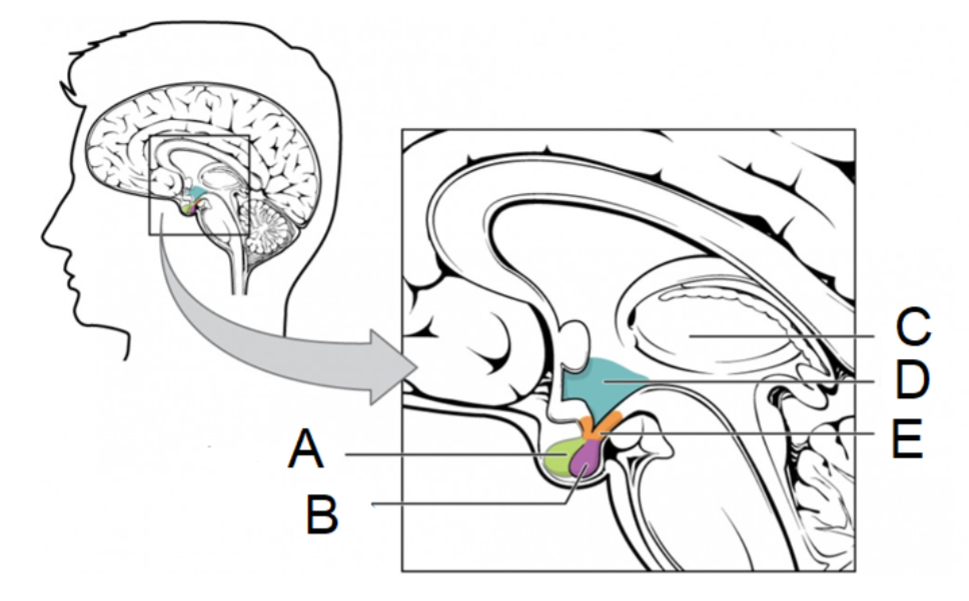
What’s A?
Anterior Pituitary
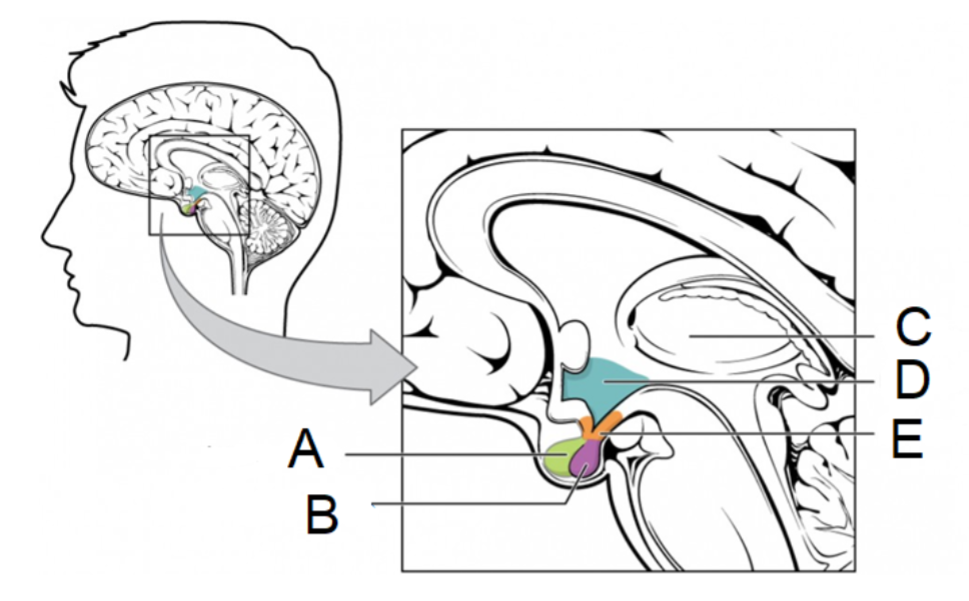
What’s B?
Posterior Pituitary
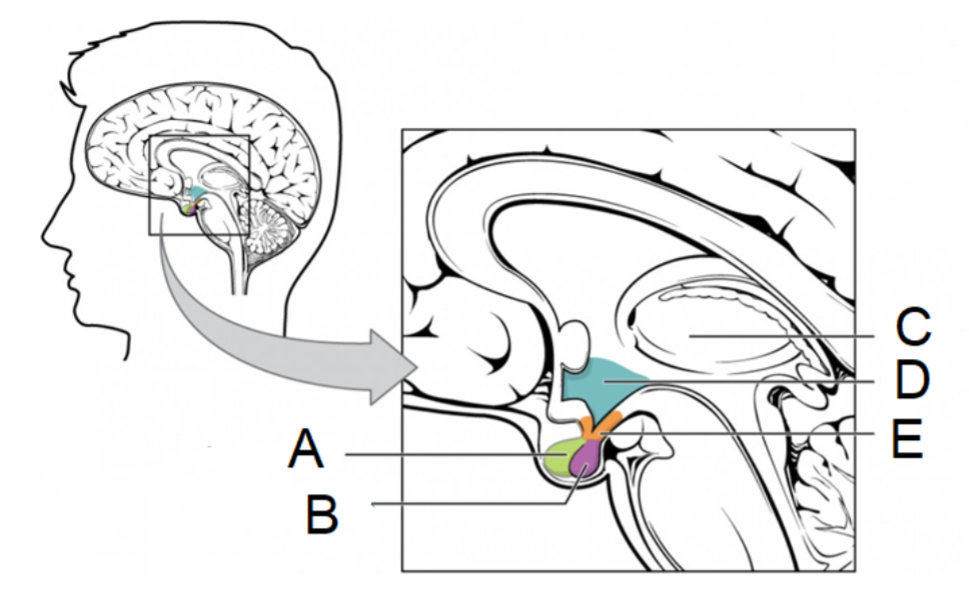
What’s C?
Thalamus
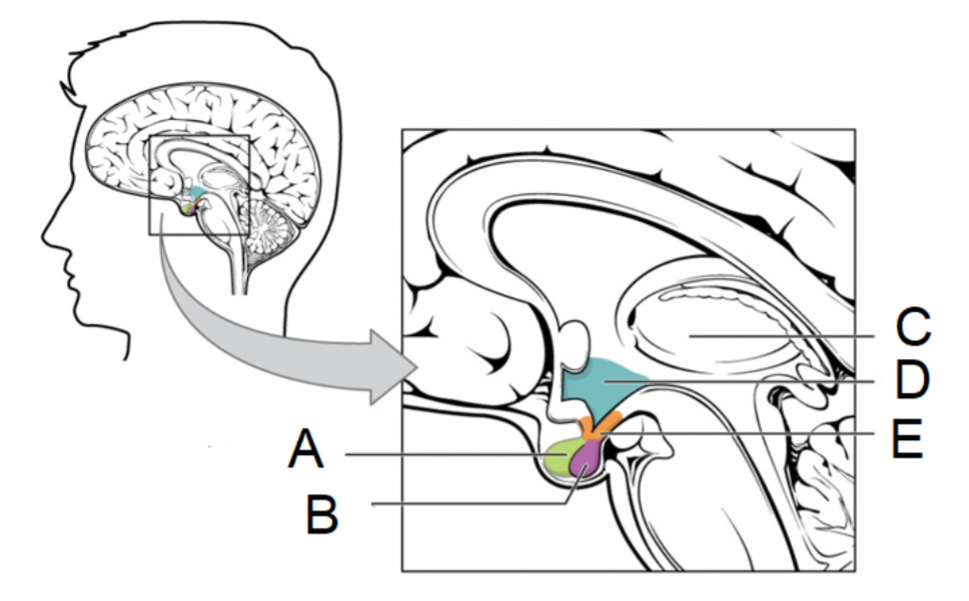
What’s D?
Hypothalamus
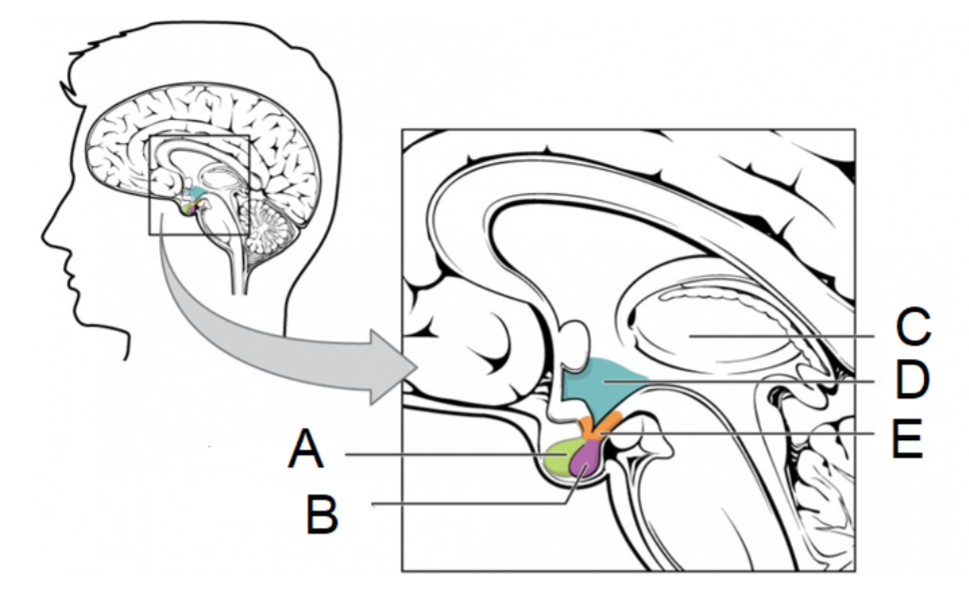
What’s E?
Infundibulum
In your own words, define the endocrine system.
A system made up of various tissues, organs, and hormones that work with the nervous system to control the activities of body cells and keep the body balanced.
The body has 2 main ways of coordinating the activity of body cells. What are these 2 systems?
The nervous system and the endocrine system.
Compare and contrast the 2 systems that your body uses to coordinate the activity of body cells.
Please summarize the similarities and differences between these systems in your own words rather than replicating the table in the notes/book.
The endocrine system uses only chemical signals (hormones) and can affect cells at short and long distances. In contrast, the nervous system uses both chemical signals (neurotransmitters) and electrical signals, but neurotransmitters only work over short distances. The nervous system responds quickly to signals, while the endocrine system's responses can vary from slow to fast. Additionally, the endocrine system reacts to changes inside the body, whereas the nervous system can respond to both internal and external stimuli.
What is the major difference between an endocrine gland and an exocrine gland?
The major difference is that endocrine glands are ductless and exocrine glands have ducts. Thus, endocrine glands secrete hormones directly into the surrounding fluid while exocrine glands release their secretions through ducts.
What are the 5 major endocrine glands in the body?
Pituitary, thyroid, parathyroid, adrenal and pineal
The Pineal Gland
(Relative location of each gland using the
anatomical directional terms, superior and inferior)
Is superior to the pituitary gland, thyroid gland, parathyroid glands and adrenal
glands.
Likewise, the pituitary gland, thyroid gland, parathyroid gland and adrenal glands are
inferior to the pineal gland.
The pituitary gland
Is superior to thyroid gland, parathyroid glands and adrenal glands but
inferior to the pineal gland.
The thyroid gland
is superior to the adrenal glands but inferior to pineal and pituitary gland.
The parathyroid glands
Are superior to the adrenal glands but inferior to the pineal gland and
pituitary gland.
The adrenal glands
Are inferior to the pineal gland, the pituitary gland, the thyroid gland, and
the parathyroid glands.
TSH released by the anterior pituitary gland stimulates the release of thyroid hormone from the thyroid gland. Would this be endocrine signaling, autocrine signaling or paracrine signaling?
Endocrine
IL1 released by an endothelial cell binds to the IL1 receptor on the same endothelial cell. Would this be endocrine signaling, autocrine signaling or paracrine signaling?
Autocrine
IL1 released by an endothelial cell binds to the IL1 receptor on a macrophage. Would this be endocrine signaling, autocrine signaling or paracrine signaling?
Paracrine
What chemical classification would you use to describe the hormone estrogen?
Steroid Hormone
Describe the difference between an amine hormone, a peptide hormone and a protein hormone.
Amine hormones are single amino acids with modifications. Peptide hormones are short chains of amino acids linked together. Protein hormones are long chains of amino acids also linked together.
What classe(s) of hormones would most likely use the Intracellular hormone receptor pathway?
Explain your reasoning.
Steroid hormones. Their structure is nonpolar and thus can diffuse through the cell membrane to access and intracellular hormone receptor.
Describe the 6 main steps in the cell membrane hormone receptor pathway.
The steps for the hormone signaling process can be simplified as follows:
The hormone binds to its specific receptor on the cell membrane.
This binding activates a G protein.
The activated G protein then activates adenyl cyclase.
Adenyl cyclase converts ATP into cAMP (the second messenger).
cAMP activates specific protein kinases.
This leads to a series of chemical reactions that result in a cellular response.
Describe the 4 main steps in the intracellular hormone receptor pathway.
The hormone diffuses through the cell membrane.
Once in the cytoplasm, the hormone binds its
specific receptor resulting in the formation of a receptor-hormone complex.
This complex then enters
the nucleus and activates gene transcription.
Gene transcription results in the production of proteins
that produce a specific cellular response.
Define positive feedback and give an example of a positive feedback loop
In simple terms, positive feedback in endocrine signaling occurs when a hormone increases its own production. For instance, during labor, oxytocin causes the uterus to contract. These contractions push the baby against the cervix, which stretches. This stretching sends signals to the brain to release more oxytocin, continuing the cycle of contractions.
Define negative feedback and give an example of a negative feedback loop
In simple terms, negative feedback in endocrine signaling occurs when a hormone stops its own production. For example, when the body is stressed, a hormone called CRH is released, which makes another hormone, ACTH, come out from the pituitary gland. ACTH then triggers the adrenal gland to release cortisol. Once cortisol is in the bloodstream, it tells the pituitary gland to stop making ACTH and the hypothalamus to stop making CRH, effectively reducing its own production.
The hypothalamus-pituitary complex is thought of as the “command center” for the endocrine system. Explain in general terms how the hypothalamus-pituitary complex works to control the endocrine system as a whole
The hypothalamus-pituitary complex controls the endocrine system by making and releasing hormones. These hormones affect target tissues and also regulate the production and release of hormones from other glands and organs in the endocrine system.
The posterior pituitary gland does not actually produce any hormones but it is involved in
storing and secreting the hormones, oxytocin and ADH (antidiuretic hormone).
Where do these hormones come from and how does the posterior pituitary gland know when to release them?
Hormones are made in the hypothalamus by neurosecretory cells. These hormones move down the cells' axons to be stored in the ends of the axons in the posterior pituitary. When the hypothalamus cells get electrical signals from the body, they release the hormones into the bloodstream.
LH
Releasing hormone = GnRH,
Target = Reproductive System,
Response = Stimulates
production of sex hormones
FSH
Releasing hormone = GnRH,
Target = Reproductive system,
Response = Stimulates
production of sperm/egg cells
TSH
Releasing hormone = TRH,
Target = thyroid gland,
response = stimulates the release of
thyroid hormone to regulate metabolism
PRL
Releasing hormone = PRH,
Target = mammary glands,
Response = stimulates production of milk
GH
Releasing hormone = GHRH, target = liver, bone, muscles, response = stimulates production of IGF (insulin-like growth factors) which in turn stimulate body growth and metabolic rate.
ACTH
Releasing hormone = CRH, target = adrenal glands, response = stimulates production of glucocorticoids which regulate metabolism and the stress response
The anterior pituitary produces 4 hormones that are called “tropic hormones”. What do tropic hormones do?
They turn on or off the function of other endocrine glands.
Releasing hormones produced in the hypothalamus must travel to the anterior pituitary to stimulate the release of hormones produced in the anterior pituitary. These releasing hormones are secreted by neurons but they travel to the anterior pituitary directly through blood vessels.
What is the name of this portal system that allows for the direct release of these hormones into the anterior pituitary?
Hypophyseal portal system
The endocrine system functions to maintain homeostasis in the body (the ability to maintain
internal stability in the body in response to environmental changes). Give 1 example of a
disorder that occurs when there is a homeostatic imbalance in the endocrine system. Also, state
which hormone is responsible for the imbalance, if there is too much or too little of the
hormone and the symptoms that would be noticeable in the patient.
1.Hypersecretion of GH (too much GH hormone) can result in gigantism in children where they grow to abnormal heights in adults this results in acromegaly where the hands, feet and face grow abnormally high.
2.Hyposecretion of GH (too little GH hormone) can result in dwarfism in children where they do not grow to a normal height.
3.Too little TH can lead to goiters or hypothyroidism. A patient with hypothyroidism would have a low metabolic rate, weight gain, cold extremities, reduced libido, menstrual irregularities and reduce mental activity.
4.Too much TH can lead to hyperthyroidism where a patient would have an increased metabolic rate, excessive body heat and sweating, diarrhea, weight loss, tremors and increased heart rate.
Additionally, the person’s eyes may bulge and they also may develop a goiter.
Describe the anatomical location of the thyroid gland.
The thyroid gland is located in the neck where it is anterior to the trachea and inferior to the larynx.
What are the three hormones secreted by the thyroid gland and what response/effect do they stimulate?
T3 and T4 – stimulate basal metabolic rate
Calcitonin, - reduces Ca2+ levels in the blood
T3 and T4
Stimulate basal metabolic rate
Calcitonin
Reduces Ca2+ levels in the blood
What stimulates the release of T3 and T4 ? What inhibits the release of T3 and T4 ?
TSH released from the anterior pituitary stimulates the release of T3 and T4 from the thyroid gland.
This is an example of a negative feedback loop, as the presence of T3 and T4 inhibits the production of more T3 and T4 by inhibiting the release of TRH from the hypothalamus and TSH from the anterior pituitary gland.
The pineal gland (Location)
Is located in the brain and is inferior and somewhat posterior to the thalamus.
Melatonin is secreted by the pinealocyte cells of the pineal gland.
Explain how the presence/absence of light works with the suprachiasmatic nucleus (SCN) to regulate sleep and alertness
Photons of light hits the retinas in our eyes, which sends a signal to the SCN in the brain. This signal stops the pineal gland from making melatonin. When melatonin is low, we feel awake. Without light, the pineal gland makes more melatonin, which makes us feel sleepy.
Describe the endocrine pathway that results in the release of sex hormones from the gonads. Be sure to include the hormone(s) released by the hypothalamus and the anterior pituitary in your answer
Gonadotropin releasing hormone (GnRH) is released from the hypothalamus which stimulates the anterior pituitary to release LH and FSH. LH and FSH stimulate the gonads to release the sex hormones (testosterone, estrogen and progesterone).
What hormones are released by the adrenal cortex?
The adrenal cortex releases glucocorticoids (like cortisol), mineralocorticoids (like aldosterone), and androgens.
What are the effects of glucocorticoids from the adrenal cortex?
They increase blood amino acid, glucose, and fatty acid levels, suppress the immune system, and affect blood pressure.
What do mineralocorticoids do?
They promote sodium and water retention and help regulate blood pressure.
How do androgens from the adrenal cortex affect the body?
Androgens are converted to estrogen or testosterone and can influence female secondary sex characteristics.
What hormones are released by the adrenal medulla?
The adrenal medulla releases epinephrine and norepinephrine.
What is the function of epinephrine and norepinephrine?
They are involved in the fight or flight response, increasing heart rate, blood pressure, dilating bronchioles, raising blood glucose levels, and boosting metabolic rates.
Where is the pancreas located?
Posterior to the bottom half of the stomach
What is the pancreatic islet?
A cluster of cells in the pancreas
What cells in the pancreatic islet produce/secrete insulin?
Beta Cells
What cells in the pancreatic islet produce/secrete glucagon?
Alpha Cells
Explain how insulin and glucagon can regulate the blood levels of glucose
When blood sugar levels are low, the alpha cells in the pancreas produce and secrete glucagon.
Glucagon then signals to the liver cells to breakdown glycogen (the stored form of glucose) into glucose and release it into the blood.
When blood sugar levels are high, the beta cells in the pancreas produce and secrete insulin. Insulin signals the cells in the body to take up glucose from the blood and promotes the formation of glycogen from glucose.
What do alpha cells in the pancreas do when blood sugar is low?
They produce and secrete glucagon.
What does glucagon signal the liver to do?
It signals the liver to break down glycogen into glucose and release it into the blood.
What do beta cells in the pancreas do when blood sugar is high?
They produce and secrete insulin.
What does insulin signal the body's cells to do?
It signals them to take up glucose from the blood and promotes the formation of glycogen from glucose.
Explain what is wrong with insulin signaling in type I Diabetes Mellitus
The beta cells are unable to produce insulin.
Explain what is wrong with insulin signaling in Type II Diabetes Mellitus
The insulin receptors on the body’s cells have become resistant to insulin signaling and no longer respond when it is present.
Gigantism is a disorder that results from homeostatic imbalance of the endocrine system where children can grow to abnormally tall heights.
What hormone is most likely to be imbalanced in patients with this disorder? Do you think there is too little or too much of this hormone in these
patients?
Over production of GH
Hyperthyroidism is due to homeostatic imbalance of thyroid hormone (TH). It can be caused by a tumor in either the anterior pituitary or the thyroid.
Explain how a tumor in either the anterior pituitary or the thyroid could
cause homeostatic imbalance of TH.
What symptoms would you expect to observe in these patients?
Anterior Pituitary → Constantly producing TSH → TH from the Thyroid Gland
Thyroid → Tumor constantly producing TH
Metabolic rate rises
A patient is found to have hypercalcemia (abnormally high levels of Ca2+)
in their blood.
What hormone is most likely to be out of balance in this
patient?
Do you think the levels of this hormone are too high or too low?
Too much PTH (Parathyroid Hormone)
Cushing’s Syndrome is a disorder caused by excessive levels of glucocorticoids (ex. cortisol) in the body. It can be caused by an ACTH-releasing tumor (in the pituitary or lungs, pancreas, kidneys or adrenal cortex) or by excessive use of glucocorticoids.
It is characterized by the “buffalo hump” and “moon face”. What other symptoms do you expect these patients will have?
Immunosupression, HBP, weight gain, increase fatty acid levels
The treatment for Cushing’s is removal of the source of the excess glucocorticoids. When the source is removed, the patient is given supplemental glucocorticoids at first and then gradually weaned off the supplemental glucocorticoids.
Given what you know about feedback loops, why would a patient initially need to be given supplemental glucocorticoids?
Excessive glucocorticoids have shut off production of CRH and ACTH for so long that the hypothalamus and anterior pituitary need time to produce CRH and ACTH again.
Hypothalamus (CRH) Negative response → Anterior Pituitary (ACTH) Negative response → Adrenal Glands (Glucorticoids “Cortisol”) Negative response
Many people and cultures (going back to ancient times) believe that the pineal gland is a spiritual center in the body and many believe it to be “the third eye”.
Given what you know about the pineal gland, why might you consider it to be “the third eye” (from an anatomical/physiological perspective)?
Anatomy = Location in between eyes inside brain
Physiology = Regulated by light / darkness
The placenta produces and secretes the following hormones: estrogen, progesterone, human chorionic gonadotropin (hCG) and human placental lactogen (hPL). The hormone, hCG, is what is detected in over the counter pregnancy tests.
Why is hCG used for this test as opposed to the other hormones produced by the placenta?
hCG is produced at the highest levels early in the pregnancy
hCG is only produced during pregnancy
Insulin is used as a treatment for both type I and type II diabetes mellitus. Based on what you know about type I and type II diabetes mellitus, explain how insulin is able to work as a treatment for both types.
Type 1 = Supplementing for a lack of insulin production
Type 2 = Increase concentration to restore sensitivity
A person with an extremely high count of neutrophils is likely suffering ________.
A) a bacterial infection
Which body activity would be most affected if a patient lacked an adequate number of
erythrocytes (anemia)?
D) oxygen transport
Loss of fibrinogen within the plasma would most likely cause which of the following?
D) loss of blood clotting
With a patient that is administered an injection of erythropoietin (EPO) you would expect to see ________.
D) increased hematocrit
Which of the choices below is the parent cell for all formed elements of blood?
C) hemocytoblast
A patient with type A positive blood can, in theory, safely donate blood to someone with ________ blood.
C) A positive or AB positive